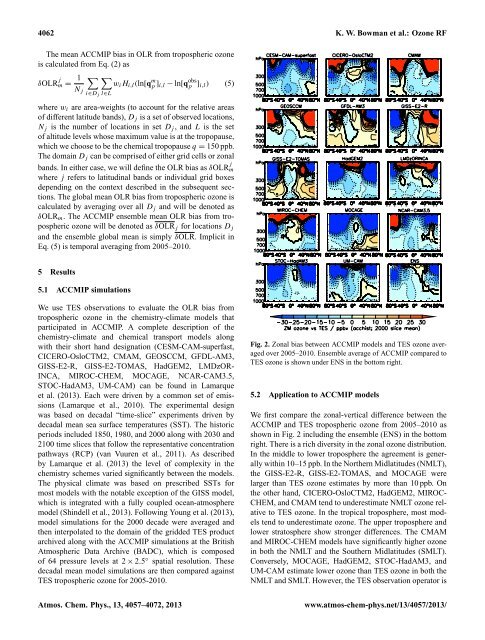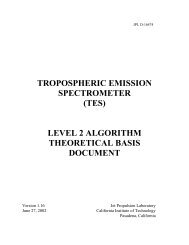Final Revised Paper - Atmospheric Chemistry and Physics
Final Revised Paper - Atmospheric Chemistry and Physics
Final Revised Paper - Atmospheric Chemistry and Physics
You also want an ePaper? Increase the reach of your titles
YUMPU automatically turns print PDFs into web optimized ePapers that Google loves.
4062 K. W. Bowman et al.: Ozone RF<br />
The mean ACCMIP bias in OLR from tropospheric ozone<br />
is calculated from Eq. (2) as<br />
δOLR j m = 1 N j<br />
∑<br />
i∈D j<br />
∑<br />
l∈L<br />
w i H i,l (ln[q m p ] i,l − ln[q obs<br />
p ] i,l) (5)<br />
where w i are area-weights (to account for the relative areas<br />
of different latitude b<strong>and</strong>s), D j is a set of observed locations,<br />
N j is the number of locations in set D j , <strong>and</strong> L is the set<br />
of altitude levels whose maximum value is at the tropopause,<br />
which we choose to be the chemical tropopause q = 150 ppb.<br />
The domain D j can be comprised of either grid cells or zonal<br />
b<strong>and</strong>s. In either case, we will define the OLR bias as δOLR j m<br />
where j refers to latitudinal b<strong>and</strong>s or individual grid boxes<br />
depending on the context described in the subsequent sections.<br />
The global mean OLR bias from tropospheric ozone is<br />
calculated by averaging over all D j <strong>and</strong> will be denoted as<br />
δOLR m . The ACCMIP ensemble mean OLR bias from tropospheric<br />
ozone will be denoted as δOLR j for locations D j<br />
<strong>and</strong> the ensemble global mean is simply δOLR. Implicit in<br />
Eq. (5) is temporal averaging from 2005–2010.<br />
5 Results<br />
5.1 ACCMIP simulations<br />
We use TES observations to evaluate the OLR bias from<br />
tropospheric ozone in the chemistry-climate models that<br />
participated in ACCMIP. A complete description of the<br />
chemistry-climate <strong>and</strong> chemical transport models along<br />
with their short h<strong>and</strong> designation (CESM-CAM-superfast,<br />
CICERO-OsloCTM2, CMAM, GEOSCCM, GFDL-AM3,<br />
GISS-E2-R, GISS-E2-TOMAS, HadGEM2, LMDzOR-<br />
INCA, MIROC-CHEM, MOCAGE, NCAR-CAM3.5,<br />
STOC-HadAM3, UM-CAM) can be found in Lamarque<br />
et al. (2013). Each were driven by a common set of emissions<br />
(Lamarque et al., 2010). The experimental design<br />
was based on decadal “time-slice” experiments driven by<br />
decadal mean sea surface temperatures (SST). The historic<br />
periods included 1850, 1980, <strong>and</strong> 2000 along with 2030 <strong>and</strong><br />
2100 time slices that follow the representative concentration<br />
pathways (RCP) (van Vuuren et al., 2011). As described<br />
by Lamarque et al. (2013) the level of complexity in the<br />
chemistry schemes varied significantly between the models.<br />
The physical climate was based on prescribed SSTs for<br />
most models with the notable exception of the GISS model,<br />
which is integrated with a fully coupled ocean-atmosphere<br />
model (Shindell et al., 2013). Following Young et al. (2013),<br />
model simulations for the 2000 decade were averaged <strong>and</strong><br />
then interpolated to the domain of the gridded TES product<br />
archived along with the ACCMIP simulations at the British<br />
<strong>Atmospheric</strong> Data Archive (BADC), which is composed<br />
of 64 pressure levels at 2 × 2.5 ◦ spatial resolution. These<br />
decadal mean model simulations are then compared against<br />
TES tropospheric ozone for 2005-2010.<br />
Fig. 2. Zonal bias between ACCMIP models <strong>and</strong> TES ozone averaged<br />
Zonal over bias between 2005–2010. ACCMIP Ensemble models <strong>and</strong>average TES ozone of averaged ACCMIP over compared 2005-2010. toEnsemble<br />
averageTES of ACCMIP ozonecompared is showntounder TES ozone ENSis in shown theunder bottom ENSright.<br />
in the bottom<br />
Fig. 2:<br />
right.<br />
5.2 Application to ACCMIP models<br />
25<br />
We first compare the zonal-vertical difference between the<br />
ACCMIP <strong>and</strong> TES tropospheric ozone from 2005–2010 as<br />
shown in Fig. 2 including the ensemble (ENS) in the bottom<br />
right. There is a rich diversity in the zonal ozone distribution.<br />
In the middle to lower troposphere the agreement is generally<br />
within 10–15 ppb. In the Northern Midlatitudes (NMLT),<br />
the GISS-E2-R, GISS-E2-TOMAS, <strong>and</strong> MOCAGE were<br />
larger than TES ozone estimates by more than 10 ppb. On<br />
the other h<strong>and</strong>, CICERO-OsloCTM2, HadGEM2, MIROC-<br />
CHEM, <strong>and</strong> CMAM tend to underestimate NMLT ozone relative<br />
to TES ozone. In the tropical troposphere, most models<br />
tend to underestimate ozone. The upper troposphere <strong>and</strong><br />
lower stratosphere show stronger differences. The CMAM<br />
<strong>and</strong> MIROC-CHEM models have significantly higher ozone<br />
in both the NMLT <strong>and</strong> the Southern Midlatitudes (SMLT).<br />
Conversely, MOCAGE, HadGEM2, STOC-HadAM3, <strong>and</strong><br />
UM-CAM estimate lower ozone than TES ozone in both the<br />
NMLT <strong>and</strong> SMLT. However, the TES observation operator is<br />
Atmos. Chem. Phys., 13, 4057–4072, 2013<br />
www.atmos-chem-phys.net/13/4057/2013/





